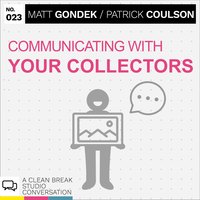Communicating
with Collectors
- by Always Art Staff


As an artist, it is important to strike a professional tone when communicating with collectors. Your relationship with collectors is important for your career progression, and how you behave will help build your reputation and your work. Many artists find it intimidating to engage with collectors early in their careers, but there are some best practices to keep in mind to ensure you develop strong professional relationships and a healthy network.
Be professional
Remember that your engagement with collectors is a business relationship. Therefore, collectors expect you, as the artist, to interact professionally. Treat collectors with respect and be polite and prompt in your responses when they are via email or phone. If you are exchanging emails, ensure your grammar is accurate and use spell check. Avoid using slang or casual text you would send to your friends and family. Strike the tone you would in the workplace and reference our email best practices for more tips about written communication.
Be clear and concise
When communicating with collectors, be clear and concise in your messages. This will show that you respect their time and energy, and you should assume that whoever is reading your message has limited time on their hands. This means that you should avoid over-sharing (plus, it’s not professional) and make sure to clearly state the main points. Use bullets to convey a list of details to avoid getting your information lost in rambling paragraphs.
Provide information about your work
Offer enough information to keep the collector engaged. When a collector buys a piece of your work, they invest in you, so they want to know about your interests, process, points of inspiration, and material choices. Share images and brief statements or content to help them understand your work and practice. Of course, send them any specific details they may ask for regarding size, medium, etc.
Be honest about your prices
Many artists find pricing to be an awkward subject, which is understandable. But when a collector asks about the price of your artwork, be honest and transparent. It is more uncomfortable to avoid the topic or make up fake prices that you think they will prefer. Stand your ground, provide a clear price list, and avoid haggling or negotiating too much. This can get messy, set up uncomfortable relationships, and lead you to undervalue your work.

Follow up
With any communication, following up with your messages when you don’t hear back is essential. Don’t take it too personally if someone forgets to respond to you; remember that everyone is busy and managing a full inbox. But, if you don’t hear back after your conversation or a sale, make sure to reach out to show that you value their opinion, the relationship, and the potential to stay in touch long-term. Always express gratitude, offer value, and express a point. This can even be a simple update on your newest work that you want to share with them.
Respect their privacy
When you form relationships with collectors, don’t spread their personal information to the public. In your conversations or sales, they may share personal information like their address or phone number. But be sure that you respect their privacy and professional boundaries by only using that information to contact them about information related to your sales and artwork, and don’t send their contact info to every artist you know.
Keep records
As you build your network, it’s important to keep thorough records so that you can keep track of all sales you make, who you share information with, and who you know. It will be embarrassing if you seem to forget your conversations or repeat yourself often in your communication. Keeping a document or log will help you maintain organized professionalism and enable you to cite your agreements if there are any disagreements or miscommunications.


